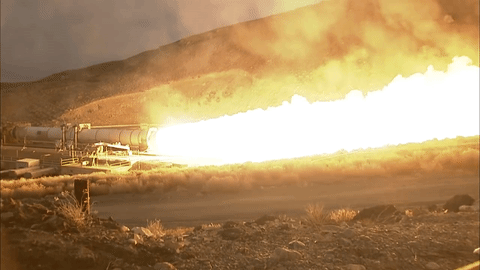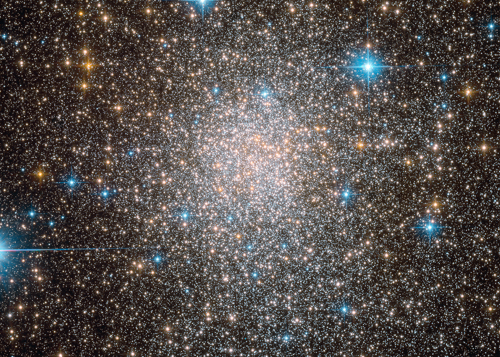Four Cool Facts About Our New Rocket’s Booster Test Firing
Four Cool Facts About Our New Rocket’s Booster Test Firing
The countdown to our last full-scale test firing of NASA’s Space Launch System (SLS) solid rocket boosters has begun (mark your calendars: June 28, 8:05 a.m. MDT [local time] 10:05 a.m. EDT). SLS is NASA’s new rocket that can go to deep space destinations, and this test is one more step on our Journey to Mars. This test will be broadcast live on NASA TV and our Facebook page. For those watching at home or work, here are four cool things that might not be so obvious on the screen.
1. So Hot, It Turns Sand Into Glass

With expanding gases and flames exiting the nozzle at speeds in excess of Mach 3 and temperatures reaching 3,700 degrees Fahrenheit, say goodbye to some of the sand at Orbital ATK’s test facility in the Utah desert because after the test, the sand at the aft, or rear, end of the booster motor will be glass.
2. This Motor’s Chill

This motor has been chilling — literally, down to 40 degrees — since the first week in May in Orbital ATK’s “booster house,” a special building on rails that moves to enclose the booster and rolls back so the motor can be test-fired. Even though SLS will launch from the normally balmy Kennedy Space Center in Florida, temperatures can vary there and engineers need to be sure the booster will perform as expected whether the propellant inside the motor is 40 degrees or 90 degrees (the temperature of the propellant during the first full-scale test, Qualification Motor 1 or QM-1).
3. This Booster’s on Lockdown

If you happen to be near Promontory, Utah, on June 28, you can view the test for yourself in the public viewing area off State Route 83. And don’t worry, this booster’s not going anywhere — engineers have it locked down. The motor is held securely in place by Orbital ATK’s T-97 test stand. During the test, the motor will push against a forward thrust block with more than three million pounds of force. Holding down the rocket motor is more than 13 million pounds of concrete — most of which is underground. The test stand contains a system of load cells that enable engineers to measure the thrust the motor produces and verify their predictions.
4. Next Time, It’s For Real

These solid rocket boosters are the largest and most powerful ever built for flight. They’ve been tested and retested in both full-scale and smaller subsystem-level tests, and vital parts like the nozzle, insulation and avionics control systems have been upgraded and revamped. Most of this work was necessary because, plainly put, SLS needs bigger boosters. Bigger boosters mean bolder missions – like around the moon during the first integrated mission of SLS and Orion. So the next time we see these solid rocket motors fire, they will be propelling SLS off the launch pad at Kennedy Space Center and on its first flight with NASA’s Orion spacecraft. For real.
More Posts from Nasa and Others
Science in space

This week on NASA Explorers, we’re aboard the International Space Station!

Now that our scientists’ experiment has made it to space, it’s time to see how their samples behave in microgravity.

See how astronauts conduct science in space, while a team back here on Earth conducts their own piece of the project. Watch the episode here:
Follow NASA Explorers on Facebook to catch new episodes of season 4 every Wednesday!
Make sure to follow us on Tumblr for your regular dose of space: http://nasa.tumblr.com
NASA’s 60th Anniversary: Home, Sweet Home
Earth is a complex, dynamic system. For 60 years, we have studied our changing planet, and our understanding continues to expand with the use of new technologies. With data from satellites, instruments on the International Space Station, airborne missions, balloons, and observations from ships and on land, we track changes to land, water, ice, and the atmosphere. Application of our Earth observations help improve life now and for future generations. Since we opened for business on Oct. 1, 1958, our history tells a story of exploration, innovation and discoveries. The next 60 years, that story continues. Learn more: https://www.nasa.gov/60
Make sure to follow us on Tumblr for your regular dose of space: http://nasa.tumblr.com.
Is Earth your favorite planet? Why or why not?
Kill the lights – We’re Simulating a Moonwalk!
At the bottom of a very dark swimming pool, divers are getting ready for missions to the Moon. Take a look at this a recent test in the Neutral Buoyancy Laboratory at NASA’s Johnson Space Center. NASA astronauts are no strangers to extreme environments. We best prepare our astronauts by exposing them to training environments here on Earth that simulate the 1/6th gravity, suit mobility, lighting and lunar terrain they'll expect to see on a mission to the Moon. Practice makes perfect.

The Neutral Buoyancy Laboratory at NASA's Johnson Space Center is where astronauts train for spacewalks, and soon, moonwalks.
When astronauts go to the Moon’s South Pole through NASA’s Artemis program, the Sun will only be a few degrees over the horizon, creating long, dark shadows. To recreate this environment, divers at the lab turned off the lights, put up black curtains on the pool walls to minimize reflection, and used powerful underwater lamps to simulate the environment astronauts might experience on lunar missions.

These conditions replicate the dark, long shadows astronauts could see and lets them evaluate the different lighting configurations. The sand at the bottom is common pool filter sand with some other specialized combinations in the mix.

This was a test with divers in SCUBA gear to get the lighting conditions right, but soon, NASA plans to conduct tests in this low-light environment using spacesuits.

Neutral buoyancy is the equal tendency of an object to sink or float. Through a combination of weights and flotation devices, an item is made to be neutrally buoyant and it will seem to "hover" under water. In such a state, even a heavy object can be easily manipulated, much as it is in the zero gravity of space, but will still be affected by factors such as water drag.
The Neutral Buoyancy Laboratory is 202 ft in length, 102 ft in width and 40 ft in depth (20 ft above ground level and 20 ft below) and holds 6.2 million gallons of water.
What's the most beautiful natural scene uou've ever seen personally, as in Aurora Borealis, volcanic eruption, or something that made you seem like the Earth should be treasured?
5 Reasons our Space Launch System is the Backbone for Deep Space Exploration
Our Space Launch System (SLS) will be the world’s most powerful rocket, engineered to carry astronauts and cargo farther and faster than any rocket ever built. Here are five reasons it is the backbone of bold, deep space exploration missions.

5. We’re Building This Rocket to Take Humans to the Moon and Beyond
The SLS rocket is a national asset for leading new missions to deep space. More than 1,000 large and small companies in 44 states are building the rocket that will take humans to the Moon. Work on SLS has an economic impact of $5.7 billion and generates 32,000 jobs. Small businesses across the U.S. supply 40 percent of the raw materials for the rocket. An investment in SLS is an investment in human spaceflight and in American industry and will lead to applications beyond NASA.

4. This Rocket is Built for Humans
Modern deep space systems are designed and built to keep humans safe from launch to landing. SLS provides the power to safely send the Orion spacecraft and astronauts to the Moon. Orion, powered by the European Service Module, keeps the crew safe during the mission. Exploration Ground Systems at NASA’s Kennedy Space Center in Florida, safely launches the SLS with Orion on top and recovers the astronauts and Orion after splashdown.

3. This Rocket is Engineered for a Variety of Exploration Missions
SLS is engineered for decades of human space exploration to come. SLS is not just one rocket but a transportation system that evolves to meet the needs of a variety of missions. The rocket can send more than 26 metric tons (57,000 pounds) to the Moon and can evolve to send up to 45 metric tons (99,000 pounds) to the Moon. NASA has the expertise to meet the challenges of designing and building a new, complex rocket that evolves over time while developing our nation’s capability to extend human existence into deep space.

2. This Rocket can Carry Crews and Cargos Farther, Faster
SLS’s versatile design enables it to carry astronauts their supplies as well as cargo for resupply and send science missions far in the solar system. With its power and unprecedented ability to transport heavy and large volume science payloads in a single mission, SLS can send cargos to Mars or probes even farther out in the solar system, such as to Jupiter’s moon Europa, faster than any other rocket flying today. The rocket’s large cargo volume makes it possible to design planetary probes, telescopes and other scientific instruments with fewer complex mechanical parts.

1. This Rocket Complements International and Commercial Partners
The Space Launch System is the right rocket to enable exploration on and around the Moon and even longer missions away from home. SLS makes it possible for astronauts to bring along supplies and equipment needed to explore, such as pieces of the Gateway, which will be the cornerstone of sustainable lunar exploration. SLS’s ability to launch both people and payloads to deep space in a single mission makes space travel safer and more efficient. With no buildings, hardware or grocery stores on the Moon or Mars, there are plenty of opportunities for support by other rockets. SLS and contributions by international and commercial partners will make it possible to return to the Moon and create a springboard for exploration of other areas in the solar system where we can discover and expand knowledge for the benefit of humanity.

Learn more about the Space Launch System.
Make sure to follow us on Tumblr for your regular dose of space: http://nasa.tumblr.com.

Commander Callie Continues Moon Mission in NASA’s Second Graphic Novel
You followed fictional astronaut, Callie Rodriguez, on her journey to the Moon in our First Woman graphic novel, “Issue No. 1: From Dream to Reality.”
In the brand new “Issue No. 2: Expanding our Universe,” find out how Callie and her robotic sidekick RT escape the lunar lava tunnel and what challenges await them on the lunar surface.
See Callie and her new crewmates work together as a team and navigate the unexpected as they take on a challenging mission to deploy a next-generation telescope on the far side of the Moon. Now available digitally in English at nasa.gov/CallieFirst and in Spanish at nasa.gov/PrimeraMujer!
Along with the new chapter, the First Woman app – available in the Apple and Google Play stores – has been updated with new immersive, extended reality content. Explore the lunar surface and learn about the real technologies we’re building to make living and working on the Moon – and eventually, Mars – possible.
Make sure to follow us on Tumblr for your regular dose of space!
Which do you think you'll miss more after your first trip? Space when you're back on Earth or Earth when you're up in Space?
I think that I will miss space when I’m back on Earth. One astronaut when she returned said that gravity sucks, so I’m looking forward to finding out what that’s like.


Even star systems have identity crises. 🤷 According to data from observatories like our @nasachandraxray, a double star system has been rapidly flipping between two alter egos: a low-mass X-ray binary and a millisecond pulsar. Astronomers found this volatile double system in a dense collection of stars known as Terzan 5. The first image from @NASAHubble shows Terzan 5 in optical light. Swipe to see the new image where low, medium and high-energy X-rays detected by Chandra are colored red, green and blue respectively. Click the link in bio for more.
Make sure to follow us on Tumblr for your regular dose of space: http://nasa.tumblr.com
On June 19, engineers on the ground remotely operated the International Space Station’s robotic arm to remove the Roll-Out Solar Array (ROSA) from the trunk of SpaceX’s Dragon cargo vehicle. Here, you see the experimental solar array unfurl as the station orbits Earth.
Solar panels are an efficient way to power satellites, but they are delicate and large, and must be unfolded when a satellite arrives in orbit. The Roll-Out Solar Array (ROSA) is a new type of solar panel that rolls open in space like a party favor and is more compact than current rigid panel designs.
ROSA is 20% lighter and 4x smaller in volume than rigid panel arrays!
This experiment remained attached to the robotic arm over seven days to test the effectiveness of the advanced, flexible solar array that rolls out like a tape measure. During that time, they also measured power produced by the array and monitored how the technology handled retraction.
Make sure to follow us on Tumblr for your regular dose of space: http://nasa.tumblr.com
-
 pepdart liked this · 6 years ago
pepdart liked this · 6 years ago -
 that-cryptid-bitch liked this · 7 years ago
that-cryptid-bitch liked this · 7 years ago -
 awesomeman281 liked this · 7 years ago
awesomeman281 liked this · 7 years ago -
 kbzmama liked this · 8 years ago
kbzmama liked this · 8 years ago -
 seanieboy392 liked this · 8 years ago
seanieboy392 liked this · 8 years ago -
 againagainagai liked this · 8 years ago
againagainagai liked this · 8 years ago -
 coctavio98-blog liked this · 8 years ago
coctavio98-blog liked this · 8 years ago -
 popizor-blog reblogged this · 8 years ago
popizor-blog reblogged this · 8 years ago -
 nwdysln reblogged this · 8 years ago
nwdysln reblogged this · 8 years ago -
 cptstevenrogers reblogged this · 8 years ago
cptstevenrogers reblogged this · 8 years ago -
 isuckfatdicks liked this · 8 years ago
isuckfatdicks liked this · 8 years ago -
 the-true-shellder-blog liked this · 8 years ago
the-true-shellder-blog liked this · 8 years ago -
 cyclic-origin reblogged this · 8 years ago
cyclic-origin reblogged this · 8 years ago -
 rgloom reblogged this · 8 years ago
rgloom reblogged this · 8 years ago -
 rgloom liked this · 8 years ago
rgloom liked this · 8 years ago -
 xptheoriginal reblogged this · 8 years ago
xptheoriginal reblogged this · 8 years ago -
 yozoshimada liked this · 8 years ago
yozoshimada liked this · 8 years ago -
 imspiderman2-blog liked this · 8 years ago
imspiderman2-blog liked this · 8 years ago -
 fleurdebach5-blog liked this · 8 years ago
fleurdebach5-blog liked this · 8 years ago -
 rod-9 liked this · 8 years ago
rod-9 liked this · 8 years ago -
 allergictonormality liked this · 8 years ago
allergictonormality liked this · 8 years ago -
 gamingonethings liked this · 8 years ago
gamingonethings liked this · 8 years ago -
 okbrenda11 liked this · 8 years ago
okbrenda11 liked this · 8 years ago -
 shuggadaddy419 liked this · 8 years ago
shuggadaddy419 liked this · 8 years ago -
 woody-yin liked this · 8 years ago
woody-yin liked this · 8 years ago -
 ruffnoiserabbits liked this · 8 years ago
ruffnoiserabbits liked this · 8 years ago -
 hancocky liked this · 8 years ago
hancocky liked this · 8 years ago -
 poisonous-owl liked this · 8 years ago
poisonous-owl liked this · 8 years ago -
 lululuvs-blog1 reblogged this · 8 years ago
lululuvs-blog1 reblogged this · 8 years ago -
 mynismud reblogged this · 8 years ago
mynismud reblogged this · 8 years ago -
 brieflyinstantruins liked this · 8 years ago
brieflyinstantruins liked this · 8 years ago -
 kawaii-potato-fornoreason liked this · 8 years ago
kawaii-potato-fornoreason liked this · 8 years ago -
 thekawaiibutterflygirl liked this · 8 years ago
thekawaiibutterflygirl liked this · 8 years ago -
 chuck3337100 liked this · 8 years ago
chuck3337100 liked this · 8 years ago -
 soultatochip420 liked this · 8 years ago
soultatochip420 liked this · 8 years ago -
 harsharan1230-blog liked this · 8 years ago
harsharan1230-blog liked this · 8 years ago -
 druidic-elora reblogged this · 8 years ago
druidic-elora reblogged this · 8 years ago
Explore the universe and discover our home planet with the official NASA Tumblr account
1K posts